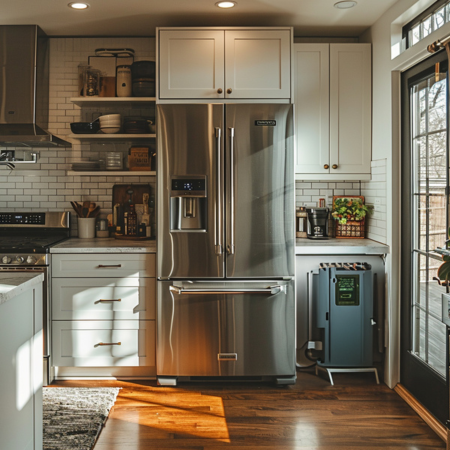Whether planning for an extended road trip, setting up a campsite, or preparing for a power outage, understanding your refrigerator’s power requirements is crucial.
One common question is, can your refrigerator run on a 1000 watt inverter?
This question is critical as it directly impacts your choice of power equipment.
Inverters, which convert DC power from a battery into AC power for appliance use, come in various sizes.
Knowing the right size for your refrigerator ensures efficient use of power and the reliability of your appliance.
This article will explore this query in-depth, providing the necessary insights to make an informed decision.
Key Point
- Refrigerator power needs vary based on size and model.
- Inverters transform DC power into usable AC power.
- A 1000 watt inverter may not power larger fridges.
- Efficient power usage relies on selecting the correct inverter.
- Improper inverter size can jeopardize refrigerator reliability.
Understanding Your Refrigerator’s Running Cycle
The refrigerator’s running cycle is not continuous — it’s intermittent. This means it switches on and off to maintain the desired temperature. So, what does this mean for power usage?
When your refrigerator starts its cooling cycle, it requires a power surge. This is the ‘starting wattage.’ It can be significantly higher than the running wattage – the power it needs to maintain operation. This difference is crucial when choosing an inverter.
A standard-sized fridge typically requires between 1200 and 1500 starting watts. However, the running wattage will likely be around 150-200 watts.
Do these numbers mean a 1000-watt inverter cannot run your fridge? Not necessarily. The key lies in understanding your refrigerator’s exact power requirements.
This involves checking its power rating. Also, consider the efficiency of your inverter. A more efficient inverter will convert more of the battery’s DC power into usable AC power.
Lastly, remember that the fridge isn’t usually the only appliance relying on the inverter. You also need to factor in the power requirements of all other appliances.
Finding Your Refrigerator’s Power Consumption
Look for the energy guide label to determine your refrigerator’s power consumption. This label provides an estimate of the annual energy use and cost. It’s usually expressed in kilowatt-hours (kWh).
The U.S. Energy Information Administration estimates that a standard refrigerator uses about 400-600 kWh annually. But, this is just an average. The actual figures can vary greatly.
Factors affecting these figures include the fridge’s age, type, and size. Older models tend to consume more power. Refrigerators with a built-in freezer compartment also use more electricity.
To calculate the actual power consumption of your refrigerator, use a wattage meter or a similar device.
This device measures the exact amount of electricity being used. It can give you a more accurate idea of your refrigerator’s power consumption.
Remember, the goal is to match your inverter’s rating with the combined power requirements of all your appliances. By doing this, you ensure efficient use of your inverter.
In summary, the right inverter for your refrigerator depends on multiple factors. These include the fridge’s starting and running wattage, power consumption, the inverter’s efficiency, and the power requirements of your other appliances.
Refrigerator Continuous Power Draw & Compressor Startup Power Surge
Every refrigerator experiences two types of power draws. The first is a continuous power draw, the constant energy your fridge uses.
The second is the compressor startup power surge. Compared to the continuous power draw, this surge lasts only a few moments. Yet, its power need is significantly higher.
The continuous power draw keeps your food at the right temperature. It’s less than the refrigerator’s maximum rating. It tends to range between 100-400 watts for most home refrigerators.

Meanwhile, the compressor startup power surge is when your fridge’s compressor kicks in. It can be two to three times the continuous power draw. You’ll need to consider this when choosing an inverter.
Why? If the inverter can’t handle the surge, it could trip. This would cut the power to your fridge. To avoid this, choose an inverter with a surge rating that can handle your refrigerator’s startup.
In conclusion, knowing your fridge’s continuous power draw and compressor startup power surge is key. It helps you choose the right inverter, ensuring your fridge runs smoothly without interruptions.
Inverter Power Ratings
Inverters come with two power ratings. The first is the Continuous Output Power. This rating tells you the amount of power the inverter can supply continuously.
The second is the Peak or Surge Power. This is the maximum power the inverter can supply for a short period.
When choosing an inverter for your fridge, consider both ratings. Your inverter’s Continuous Output Power rating should be higher than your fridge’s continuous power draw. This allows the inverter to handle the fridge’s regular operation.
The inverter’s Peak Power rating should be higher than the fridge’s compressor startup power surge. This ensures the inverter can handle the initial power surge when the compressor starts.
Remember, the inverter’s efficiency also matters. This affects how much power it delivers to the fridge from the source. If the inverter is less efficient, it will require more power.
In the end, remember to balance all considerations. The aim is to ensure your fridge runs without hiccups. Choose the right inverter for a smoothly running refrigerator.
Which Is Better – Pure Sine Wave Or Modified Sine Wave?
When choosing an inverter, you must choose between pure and modified sine wave models. Each type has its merits and drawbacks.
Pure sine wave inverters are the gold standard. They generate a smooth, clean current. This matches the power from your electrical grid.
Hence, they’re the best choice for sensitive electronics. They minimize electrical noise and interference. However, they come at a higher cost.
Modified sine wave inverters are cost-effective. They work well for many appliances. But, their output is less smooth.
This can cause interference in sensitive devices. Also, some appliances run less efficiently on modified sine wave power.
In conclusion, the choice depends on your usage. If your fridge has sensitive electronics, go for a pure sine wave inverter.
If cost is a concern, a modified sine wave inverter may suffice. Always remember to check the appliance’s requirements.
Can Your Refrigerator Run On A 1000 Watt Inverter?
Yes, a refrigerator can run on a 1000-watt inverter. But, it depends on the fridge’s power consumption.
Most medium-sized fridges use between 100 to 200 watts per hour. This is well within the capability of a 1000 watt inverter. However, a fridge’s startup power may be up to 2 to 3 times its normal power. So, ensure your inverter can handle this surge.
Also, remember efficiency matters. The inverter must efficiently convert power from the source. A less efficient inverter will require more power.
In conclusion, a 1000 watt inverter can power a fridge. But, consider the fridge’s power consumption and the inverter’s efficiency. Also, check it can handle the startup power surge.
What Size Of Inverter Is Required To Run A Refrigerator?
The size of the inverter required to run a refrigerator depends on the fridge’s power consumption. This is typically mentioned in the owner’s manual or on the appliance itself.
Take note of two values – operating power and startup power. Operating power is the amount of power the fridge needs to run continuously. Startup or surge power is the initial burst of energy required when the fridge starts. This is often 2 to 3 times the operating power.

For instance, let’s say your fridge has an operating power of 150 watts. The startup power might be around 450 watts. Therefore, you’d need an inverter that can handle at least 450 watts.
However, it’s wise to have a buffer. A suitable inverter would be one rated at around 600 watts. This leaves room for power fluctuations or additional load.
Remember, an inverter’s efficiency also matters. A more efficient inverter will convert DC power to AC power with minimal loss. This is vital to keep your fridge running smoothly.
In short, to determine the inverter size for your fridge, consider the operating power, startup power, and the inverter’s efficiency. Always aim for a higher rating than the minimum requirement.
Tips For Running A Refrigerator On An Invertor
Running a refrigerator on an inverter doesn’t have to be a daunting task. You can ensure efficient operation with careful planning and adherence to a few important tips. Here are six useful tips to consider:
- Choose an Energy-Efficient Fridge: Refrigerators with higher energy ratings consume less power, making them ideal for running on inverters.
- Maintain Optimal Temperature Settings: Avoid setting the refrigerator to its coldest setting as it consumes more power.
- Limit Door Openings: Each time the refrigerator door is opened, cold air escapes, increasing power consumption.
- Prevent Overloading: Overloading the refrigerator can make it harder for the appliance to maintain a consistent temperature, thereby using more power.
- Regular Maintenance: Regular servicing helps ensure the fridge’s efficient operation, reducing power consumption.
- Use an Inverter with a High-Efficiency Rate: An efficient inverter minimizes power loss during the conversion from DC to AC power.
Conclusion
Running a fridge on an inverter is feasible with the right planning. Choose energy-efficient models. They consume less power. Adjust your temperature settings. The coldest setting uses more energy.
Avoid frequent door openings. It lets cold air escape. Don’t overload the fridge. It strains the system. Timely maintenance is key. It keeps the fridge running smoothly.
Lastly, pick an inverter with high efficiency. It ensures lesser power loss. With these tips, maintaining a refrigerator on an inverter becomes manageable, economical, and efficient.
- Can You Put Microwave Popcorn In The Oven: Pros And Cons - May 14, 2024
- Can You Scrap A Microwave And Why You Should? - May 13, 2024
- Can You Put Metal In A Convection Microwave: 10 Major Risks - May 12, 2024

